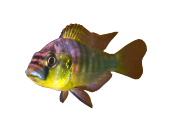Hofmann HA, Benson ME, Fernald RD.
Social status regulates growth rate: consequences for life-history strategies. Proceedings of the National Academy of Sciences of the United States of America [Internet]. 96 (24) :14171 - 6.
Publisher's VersionAbstractThe life-history strategies of organisms are sculpted over evolutionary time by the relative prospects of present and future reproductive success. As a consequence, animals of many species show flexible behavioral responses to environmental and social change. Here we show that disruption of the habitat of a colony of African cichlid fish, Haplochromis burtoni (Günther) caused males to switch social status more frequently than animals kept in a stable environment. H. burtoni males can be either reproductively active, guarding a territory, or reproductively inactive (nonterritorial). Although on average 25-50% of the males are territorial in both the stable and unstable environments, during the 20-week study, nearly two-thirds of the animals became territorial for at least 1 week. Moreover, many fish changed social status several times. Surprisingly, the induced changes in social status caused changes in somatic growth. Nonterritorial males and animals ascending in social rank showed an increased growth rate whereas territorial males and animals descending in social rank slowed their growth rate or even shrank. Similar behavioral and physiological changes are caused by social change in animals kept in stable environmental conditions, although at a lower rate. This suggests that differential growth, in interaction with environmental conditions, is a central mechanism underlying the changes in social status. Such reversible phenotypic plasticity in a crucial life-history trait may have evolved to enable animals to shift resources from reproduction to growth or vice versa, depending on present and future reproductive prospects.
 1999.hofmann.pnas_.pdf
1999.hofmann.pnas_.pdf 
